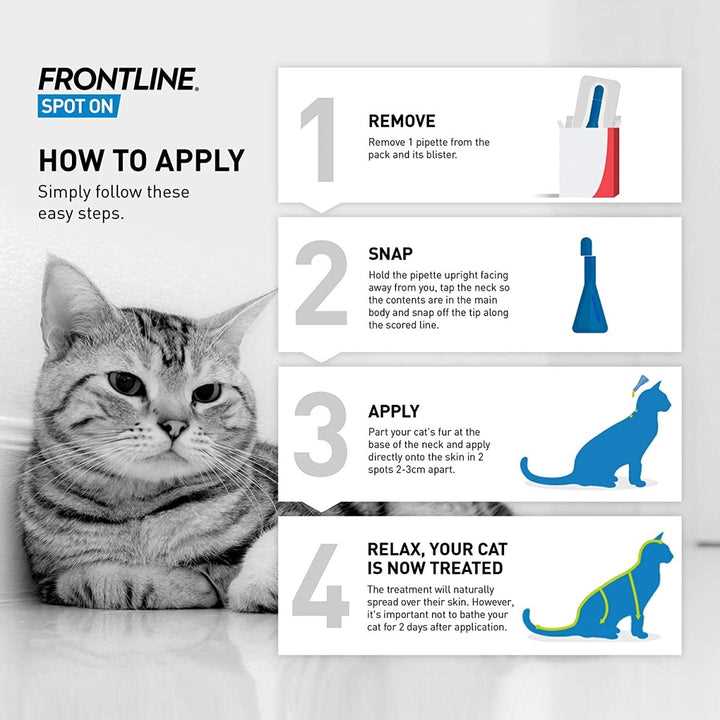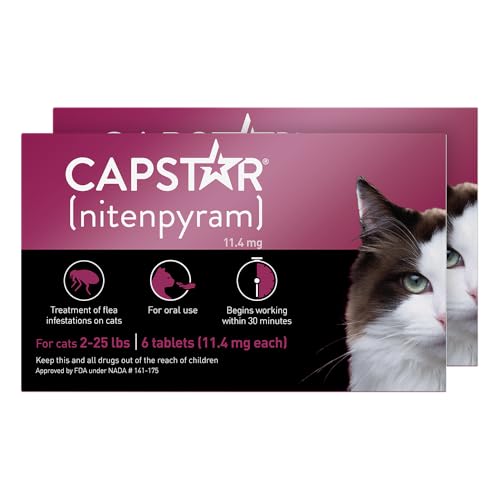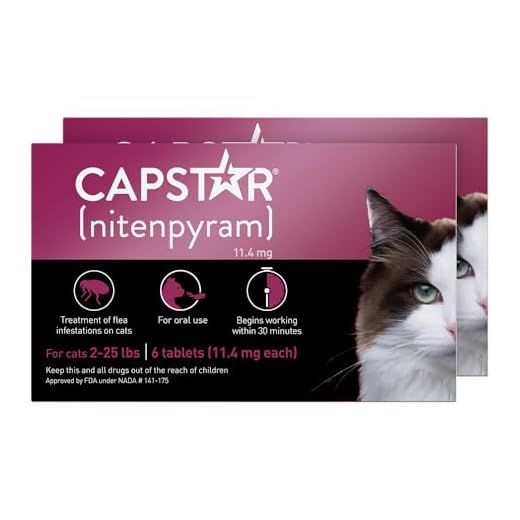




For those caring for mother cats and their kittens, addressing unwanted parasites is a priority. This article outlines safe and suitable options for eliminating these pests, ensuring the health and comfort of both the queen and her young.
Throughout the text, I will provide insights into various products available on the market, highlighting their safety profiles and application methods. You’ll learn about topical solutions, oral medications, and natural alternatives, all tailored to suit the unique needs of nursing felines.
This guide is designed for pet owners seeking reliable methods to protect their furry companions from infestations while maintaining the well-being of their brood. By the end of this article, you’ll have a clear understanding of which options are best suited for your situation and how to implement them effectively.
Optimal Solutions for Flea Control in Nursing Felines
Choosing the right method to combat parasites in nursing felines is critical for their health and the well-being of their kittens. Products that are safe and gentle yet effective are necessary to ensure both maternal and juvenile safety. It’s advisable to consult with a veterinarian before introducing any form of pest management.
Natural remedies can offer an alternative approach, providing relief without harmful chemicals. Regular grooming with a fine-toothed comb can assist in physically removing unwanted pests, while baths with mild, pet-safe soap may help to diminish any existing infestation.
Considerations in Selecting Treatments
When assessing options, keep in mind the following factors:
- Safety: Ensure any product used is approved for use on nursing mothers and their young.
- Ingredients: Opt for formulations that utilize natural components, minimizing the risk of adverse reactions.
- Application method: Choose easy-to-apply solutions that won’t stress the feline or her kittens.
Monitoring the environment is also essential. Regular cleaning of the living space and bedding can significantly reduce the likelihood of recurrence. Vacuuming and washing items in hot water can help eliminate eggs and larvae.
Finally, maintaining a regular schedule for preventative care will ensure a long-term solution to this issue, keeping both mother and her offspring healthy and comfortable.
Understanding the Risks of Flea Infestations in Nursing Cats
Addressing parasitic invasions in new mothers is critical for their health and the wellbeing of their kittens. Infestations can lead to a range of complications, impacting both the mother and her offspring. In addition to discomfort, these pests can transmit diseases that pose significant health risks, making timely intervention essential.
Parasites can cause anemia, especially in nursing felines, due to blood loss. This condition may lead to fatigue and a weakened immune system, affecting the mother’s ability to care for her young. Kittens may also suffer from malnutrition if the mother is unable to feed them adequately due to her own declining health.
Potential Health Issues Linked to Infestations
Beyond immediate discomfort, multiple health concerns arise from a parasitic presence:
- Dermatitis: Skin irritation and inflammation can occur, leading to excessive scratching and further skin damage.
- Infections: Open wounds from scratching may become infected, requiring veterinary attention.
- Intestinal problems: Some parasites can cause gastrointestinal disturbances, leading to diarrhea and vomiting in both mother and kittens.
Prompt identification and management of these issues are vital to ensure the health of both the mother and her kittens. Regular veterinary check-ups can aid in early detection and prevention, safeguarding against long-term health implications.
Safe and Effective Topical Treatments for Lactating Felines
When dealing with external parasites in lactating felines, using topical solutions that are safe for both the mother and her kittens is essential. Products containing ingredients like fipronil or imidacloprid are commonly recommended. These active substances target adult parasites without posing significant risks to nursing offspring.
Before applying any solution, it is crucial to consult a veterinarian to ensure the selected product is appropriate for the specific situation. Some formulations are designed with lower concentrations or specific delivery systems to minimize absorption into the bloodstream, thus reducing potential risks to nursing kittens.
Application Guidelines
Proper application of topical solutions is vital for maximizing their effectiveness:
- Ensure the cat is dry before application to enhance absorption.
- Apply the solution directly onto the skin, ideally between the shoulder blades, to prevent the cat from licking it off.
- Follow the manufacturer’s instructions regarding the dosage and frequency of application.
Monitor the mother and kittens after treatment for any adverse reactions, such as unusual behavior or skin irritations. If any concerning symptoms arise, contact a veterinarian promptly.
Alternative Approaches
In addition to topical solutions, consider integrating environmental control measures:
- Regularly vacuum living areas to remove any parasites and their eggs.
- Wash bedding and toys frequently to maintain a clean environment.
- Use natural deterrents like diatomaceous earth in areas where the cats spend time, ensuring it is safe for both the mother and her young.
In conclusion, selecting safe and appropriate topical applications, coupled with diligent environmental upkeep, can significantly reduce the risk of infestations in lactating felines while protecting their health and that of their kittens.
Oral Medications: What to Consider for Nursing Cats
When selecting oral medications for lactating felines, it’s crucial to prioritize their safety and the well-being of their kittens. Certain formulations may pose risks to both the mother and her offspring. Always consult a veterinarian before administering any medication.
Focus on products that are specifically designed for use in nursing animals. Many standard treatments may contain ingredients that can be harmful to young kittens or may not be adequately tested for pregnant or nursing pets.
Key Factors to Evaluate
Evaluate the following aspects when considering oral medications:
- Ingredient Safety: Ensure that the active ingredients are safe for both the mother and her kittens. Some compounds can be transferred through milk, potentially harming the young.
- Dosing Instructions: Pay attention to dosage guidelines. Overdosing can lead to severe side effects, especially in nursing mothers.
- Duration of Use: Consider the recommended duration for administration. Extended use may lead to complications or resistance.
- Manufacturer Information: Research the manufacturer’s reputation and consult reviews or feedback from other pet owners.
- Veterinary Recommendations: Follow the advice of a veterinarian for tailored recommendations based on the individual health profile of the cat.
In summary, careful consideration of these factors will help ensure the safety and health of both the mother and her kittens during the treatment process.
Natural Remedies and Their Efficacy in Flea Control
Essential oils like lavender, peppermint, and cedarwood have shown promise in repelling unwanted insects. These oils can be diluted with a carrier oil and applied to the fur of felines, providing a natural barrier against these nuisances. However, caution is necessary as certain oils can be toxic to small animals if used improperly.
Herbal solutions, including diatomaceous earth, can be beneficial in managing infestations. This natural powder works by damaging the exoskeleton of insects, leading to dehydration and death. Sprinkling it in areas where the feline frequents may help reduce the presence of these insects significantly.
Other Natural Approaches
- Apple Cider Vinegar: This vinegar can be mixed with water and sprayed onto the coat as a natural repellent.
- Salt: A common household item, salt can be sprinkled on carpets and furniture to dehydrate and kill insects, but thorough cleaning is necessary afterward.
- Herbal Flea Collars: Crafting a collar using herbs like rosemary or lemongrass can deter insects naturally.
While these natural solutions provide a degree of control, their effectiveness may vary. Regular cleaning of the environment and combing the fur can enhance the results of these remedies. Consulting with a veterinarian before implementing any new strategy is advisable to ensure the safety and well-being of the cat.
Preventative Measures to Protect Nursing Cats from Fleas
Regular grooming is a fundamental strategy to minimize the risk of infestations. Brush the fur of your feline companion at least once a week, paying close attention to areas where pests are likely to hide, such as behind the ears and under the belly. This practice not only removes dirt and loose hair but also helps in spotting any signs of unwanted creatures early.
Maintain a clean living environment. Vacuum your home frequently, focusing on carpets, furniture, and any areas your cat frequents. Dispose of the vacuum bag or empty the canister outside to prevent re-infestation. Wash bedding and any fabric items your kitty uses in hot water to eliminate eggs and larvae.
Additional Preventative Tips
- Use natural repellents such as diluted essential oils (ensure they are safe for cats) to deter pests.
- Keep your outdoor space tidy by trimming grass and removing debris, creating an unwelcoming environment for pests.
- Install flea traps to monitor and reduce pest populations in your home.
- Consider the use of preventive collars that are specifically formulated to repel unwanted insects.
- Consult with a veterinarian about safe options for preventative measures that can be applied to your furry friend.
By integrating these strategies into your routine, you can create a safer living space for your feline and her kittens. Regular monitoring and prompt action are key to ensuring a pest-free environment.
Best flea treatment for nursing cats
Features
| Part Number | 3137 |
| Model | 3137 |
| Warranty | Contact the manufacturer. |
| Color | Pink |
| Size | 12 Count |
Features
| Part Number | Fldstryr-Nem-16oz-001 |
| Size | 16 oz |
Features
| Part Number | 86336774 |
| Model | 86336774 |
| Color | Large Cat only |
| Release Date | 2023-05-29T00:00:01Z |
| Size | 6-Pack |
| Language | English |
Features
| Part Number | 21456290PK |
| Model | 21456290PK |
| Color | Blue |
| Size | 4.1-17 lbs |
Features
| Part Number | Large Tag |
| Model | 850039618666 |
| Size | Regular Tag |
Features
| Part Number | FLA03933-2 |
| Model | FLA03933-2 |
| Warranty | 1 year manufacturer |
| Color | Chewable Tablets |
| Size | 2 Pack |
Video:
FAQ:
What are the safest flea treatments for nursing cats?
When it comes to nursing cats, safety is a top priority. Many flea treatments contain ingredients that can be harmful to kittens, so it is crucial to choose products that are specifically designed for use on nursing cats. One of the safest options is to use topical treatments that contain selamectin or fipronil, as these have been found to have minimal effects on nursing kittens. Additionally, natural remedies like diatomaceous earth or a flea comb can help reduce flea populations without the risks associated with chemical treatments. Always consult with a veterinarian before starting any treatment to ensure it is suitable for your cat and her kittens.
How should I apply flea treatment to my nursing cat without affecting her kittens?
Applying flea treatment to a nursing cat requires careful consideration to avoid exposure to her kittens. First, it’s advisable to choose a flea treatment that is labeled safe for nursing cats. When applying the treatment, do so in a separate area away from the kittens to minimize contact. Follow the product’s instructions closely for dosage and application method. After application, ensure your cat does not groom her kittens until the treatment has dried completely. Additionally, keep the environment clean by regularly vacuuming and washing bedding to help control flea populations. If you have any concerns or if your cat shows any adverse reactions after treatment, contact your veterinarian immediately.










